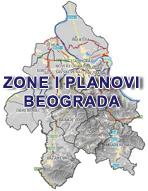LANDSCAPE ARCHITECTURE IN SERBIA -ASLA
Landscape Architecture in Serbia.To read the original text go to: http://www.asla.org/ppn/Article.aspx?id=34376one part of the text is in DIRT. ASLA: http://dirt.asla.org/2012/01/31/landscape-architects-can-help-heal-serbia/ |
|||||||||||||||||||||||
| by Nevenka Milic Chavez & Maja Todorović Izquierdo | |||||||||||||||||||||||
Serbia is a land of great natural beauty—mountains, canyons, caves, gorges, and primeval forests that have been torn apart for centuries by war.
The land has been cultivated for more than seven thousand years. Around 5,300 BC, the people of the Lepen Whirl culture began to expand from Djerdap, the biggest gorge in Europe, domesticating animals, and starting to farm. Fields expanded, towns became cities that included small parks, and during the middle ages, defensive castles and religious monasteries created walled gardens for aromatic and healing herbs, as well as relaxation and meditation. Turks occupied the country from 1459 to 1804, establishing large fortifications around major cities, with open spaces in the middle. After the Turks were driven out of the country though, many of the forts were torn down, leaving vast spaces for new parks, and green belts around towns. For example, the Kalemegdan park in Belgrade, which was constructed in 1925, offers views of both the Danube and the Sava rivers.
After peace was restored, the region was left with an enormous rebuilding and repair challenge. While there were established landscape architecture education programs and organizations (see discussion below), landscape architects faced and continue to face the challenge of revitalizing damaged downtown and metro areas, restoring parks and green belts, and making urban forests more appealing to people who want to escape the pressures of a fragile economy, constant signs of the war, and incessant media.
In Serbia, formal landscape architecture education started in 1956 at the College of Forestry at the University of Belgrade, with a program initially known as “Landscaping and Beautification of Residential Areas.” Later the program was changed to “Landscape Architecture and Horticulture,” to reflect the Russian standard, with a focus on forestry and biotechnology, not design. Graduate courses followed German standards. Following the ideas of the European Council of Landscape Architecture Schools, the College of Forestry decided in 2009 to offer graduate (master level) studies in Landscape Architecture in addition to the existing undergraduate and postgraduate studies. The four-year program at the College of Forestry is still heavily influenced by the field of horticulture, but it has broadened its focus to include: • Planning, design, and development of urban and open spaces • Establishment of new open spaces, reconstruction of existing ones, historical and cultural preservation • Nursery production, maintenance and pest and disease control, native plant material and ecosystems of Serbia • Landscape architecture project management and economics There is another accredited landscape architecture program at the College of Agriculture in Novi Sad. Individual courses in landscape architecture are also offered at the College of Architecture in Belgrade, and in the colleges of Geography and Architecture at the University of Nis. Landscape architecture is also being taught within the Department of Architecture at Megatrend University in Belgrade. This program takes a contemporary approach, combining various fields that influence landscape architecture, such as geology, botany, biology, architecture, urban design, and land art while introducing social and economic factors, project management, and communication.
Professional Organizations in Serbia The first Association of Landscape Architects of Yugoslavia was established in 1983 in Dubrovnik, Croatia, and in 1987 became a member of the International Federation of Landscape Architects (IFLA). Civil war in Yugoslavia led to dissolution of the association and it was not until 1996 that it was reestablished as the Association of Landscape Architects of Serbia and Montenegro, and its headquarters moved to Belgrade, Serbia. In 2006, when Serbia and Montenegro separated, the organization was renamed the Association of Landscape Architects of Serbia. Recently, the organization also launched the Serbian Landscape Architecture Magazine. In 2007, the College of Forestry and the Department of Landscape Architecture hosted the European Council of Landscape Architecture Schools Conference. The motto was “Building bridges to the future environment for Europe.” This event reopened and reestablished damaged international relations caused by the war. Then, in 2007, Andreja Tutundzic, from the College of Forestry, became the European Federation for Landscape Architecture’s Vice President for Education. The association now hosts a biannual meeting, expo and conference, and meetings and exhibits in other cities throughout Serbia. The meetings are attended by individuals from several European and African countries. At the 3rd Exhibition of Landscape Architecture, 103 works were submitted for awards, and 70 were chosen and entered the contest for rewards. A group of students from Landscape Architecture in the College of Forestry were awarded a Grand Prix award for their work, “Urban Pockets of Belgrade,” which analyzed abandoned urban lots in Belgrade in an attempt to get public involved in their revitalization and reuse.
Maja Todorović Izquierdo is an Assistant Professor at the Faculty of Arts and Design, Megatrend University in Belgrade. She may be reached at: mayaizqu@gmail.com.References
Gimbutas, M. (1974): The Goodness and Gods of old Europe, University of California Press: 110.
Organisation Board of III Landscape architecture
exhibition in Serbia (2009): Report on the III Landscape archi¬tecture
exhibition in Belgrade in IFLA Newsletter, N 85: 15.
Tutundzic A., Vujicic D. (2007): Landscape architecture in Serbia in EFLA Newsletter, N 18: 11-12.
www.upa.org.rs http://urbani-dzepovi-beograda.weebly.com/. www.le-notre.org. http://pejzaznarhitektura.blogspot.com |



Коментари
Постави коментар
Ovde možete ostaviti vaš komentar i sugestije